
What is a mature technology?
One that finally generates as many problems as it solves.
--Theodore Roszak
The Future is fun! The Future is Fair! You may already
have won! You may already be there!
-- The Firesign Theatre
. . . the machinery of the technological universe is 'as such'
indifferent towards political ends -- it can revolutionize
or retard society. . . . However, when technics becomes the
universal form of material production, it circumscribes an
culture, it projects a historical totality -- a 'world'.
-- Herbert Marcuse
I
The Tyro.
In the early 1980s I lived through Silicon Valley's "electronic revolution" with much trepidation. Except for the obvious conveniences it brought to word-processing for writers like myself, I was wary of the origins of this technology in the military-industrial complex and concerned about its reach into, and effect upon, our private and public selves.I entered into the computer era in 1983 via a Radio Shack TRS Model 4 rig, but my interest in "procedural thinking" as exemplified by computers had already been broached in my early conceptual artworks. In 1974 I produced my performative artwork titled Orders, a piece inspired by a robot-in-a-car toy which I once had that could be programmed so that the electric car could to go straight, left, or right in a repeating ten-step loop. In Orders, I wrote a simple open template that others could fill-in, programming me to follow a ten-block walk starting from any intersection indicated on the form. For the duration of the piece (during which I was what we'd call today the programmer's "avatar") I was to do exactly what my "programmer" commanded. One person had me walk into a military cemetery; another added several blocks to the program, so I unknowingly marched a swastika pattern in a Jewish neighborhood. Only later in tracing my walk on a map did I discover what I'd been programmed to do. Such "programs" took the piece to a level of discussion about "following orders" and social and ethical responsibility. Were I to redo the piece today, I would have a web-form with radio buttons and fill-ins on-line, tapping into the potential for world-wide range of "programmers" and audience, all at a mouse's touch. I had, moreover, anticipated my current interest in the potential of electronic writing, in hypertexting, in yet another conceptual work. Across: A Phenomenological Short Story (1973) consisted of a brief story about two people crossing a street in which the writing's tense (whether the action was before, during, or after) was ambiguous and each paragraph contained on a separate laminated strip could be assembled in any syntactical order the reader chose. Again, had I only had today's technology then.
Well, I kept that Radio Shack rig for seven years, before picking up a new IBM PS/1 (286) machine. Compact and more reliable than today's computers, it was unique in employing a Mac-like graphical interfacing DOS shell which crudely anticipated the flexibility of my current Windows 95 platform. For several years I used this faithful little machine, resisting the advancing computer technology with all the bells and whistles of fast modems, browsers, plug-ins, speakers, joy-sticks, and the lure of virtual reality. Theodore Roszak in The Cult of Information cleverly captured this consumer resistance as: "Now seems never the time to buy."

As academic Joseph Lockard observed contra the ideology of increasing computer affordability: "Cyberspace is expensive space." [1] And frustrating space too. The next generation of computers seemed, as Joseph Campbell wittily put it, more "an Old Testament god with a lot of rules and no mercy." Yes, I looked askance at it all -- at having to learn a new operating system just when I'd finally mastered all the DOS commands, at solipsistic USENET and BBS sites where the like-minded exchange e-mail, re-enforcing their narrow versions of reality and trying to convince themselves of their immaterial existence as a new kind of classless spiritual community (and it may really seem so to those suffering the decline in the quality of community we experience in the USA); looked askance at digital cameras and PhotoShop, at the ever-evolving versions of software and the prevalence of "fritterware," and at the stacks of tech manuals waiting to be devoured as just more marketing hype and superfluous distraction that maintained the free-markets-solve-all ethos. Until about two years ago, that is.
But then I couldn't obtain much software any longer for my ancient (read four-year-old) PC. Nor could I understand what many of my students were talking about, or catch their references. And so I was sort of dragged into a generation of Windows technology, color ink-jet printers, scanners, and the World Wide Web out of curiosity and pedagogical necessity. I found myself picking the brains of bright folks thirty years my junior. The me-teacher-you-student role became wonderfully reversible. I upgraded again, and again. More RAM, a faster modem and CPU, two internal hard-drives, an external drive, a recordable/rewritable CD-ROM, a scanner, a sound card with stereo speakers -- and software! Browser and e-mail software; software to create gifs, to animate them, to combine them; software to manage the software. Tech manuals on Windows, Netscape, HTML, Java, Perl, and PhotoShop. In point of fact, a home system never gets completely bought! New terms to absorb: applets, cgi-bin, firewall, ftp, grep, unzip, bots. Hacker jargon to learn: bogotify, fritterware, Hanlon's Razor, hysterical reasons, octal forty, slack, digerati, vaporlink, clickstream, luser, etc.Exciting, but daunting; might even turn one into a jargonaut.
After Sagans (hackish for "billions of billions") of seconds on-line, I found a considerable drop in my use of the Net. (See Chris Johnson 's "Why CHI (Computer-Human Interaction) has Failed to Improve the Web" which discusses such user behavior). Despite all the bells and whistles and bucks dumped into my machine, I found myself finger-tapping during long downloads, grading papers while up-loading web page files at 30 kbps, getting frustrated with automatic line cut-offs, and reading e-mail complaints about browser incompatibilities with our Netscape-produced home page.
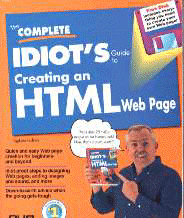
Virtual World Pluralism?
I relate this "coming-of-age-in-the-electronic-era" story because it is typical of many Baby Boomers' trials and tribulations with the new technology and their ambivalence toward those much touted anarchic "virtual communities" popping up on Usenets, BBSs, MUDs, IRCs. As often remarked, these cyber-communities seem to lack effective ways to move from an expression of personal experience into a contestatory public sphere wherein the personal can be represented as political, where personal testimony can be brought to bear upon political change as accomplished by those proverbial New England town meetings (An example of this problem of personal complaint outweighing empowerment is the BBS "Letters to a Dead Man" where one merely sits back helplessly exchanging comments with Dean, a death-row inmate at San Quentin Penitentiary, while his execution-date looms ever closer). Steven G. Jones, a Professor of Communications, thinks the Internet cannot make a polity from such narratives. He faults the ongoing message threads which "do little more than sum up discussion, so do not provide participation, reflection, and critical debate" ("The Internet and its Social Landscape," 1997). Compared to the popular media, the Net so far represents a more diverse range of identities. But it needs to move from mere virtual-world pluralism, a mish-mash of opinions like talk-show babble, toward focused, empowering political consensus that can effect actual change, can impact the real world events.Will we one day see what Chaos theorist, James Gleick, envisions: the erasure of the distinctions between on-line and off-line, producing an empowered virtual community? Yet will this really be a community, or only an anti-social free-for-all as Joseph Lockard (a member of the Web's "Bad Subjects Collective" and a regular contributor to their magazine) fears?
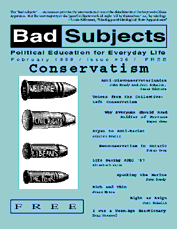
I found something of my own ambivalence over the efficacy of the such virtual communities expressed in a commentary by a young woman found in the "What's New?" section of the e-zine Surveillance's Millennium. Using the pen name of "Mellon Collie," she addresses her personal need for "understanding" and reveals her sense of the abyss yawning between real life conversation and the Web's IRC chat- rooms where "flaming" is common and "cyber-rape" may occur. Yet in these chat-rooms there is also the expectation of sociability, of exchange, and even of empathy -- which "Mellon Collie" complains she hasn't received. She desires to lessen this abyss in cyber-chat by desperately seeking the digerati, those beautiful people of the on-line world. But by the very distance her on-line dialogues entail between the participants, she also sustains that abyss. This is a "perfect closeness yet an infinite remove" that Steven G. Jones calls "aimless connectedness," or what one Internet user cited by Jones termed more positively as "a time to be alone and yet be with others." But who others? There's the humiliating possibility in IRC that one is not communicating with a person but a "bot."
So one must question whether these chat-rooms, in being enthusiastically compared to the empowering conviviality of the eighteenth-century coffeehouse, are correctly touted as a new site of public discourse. This "public sphere" envisioned by contemporary German theorist Jürgen Habermas is an ideal and modernist program of social communication which is aimed at relighting the Enlightenment flame of rational discussion and consensus (see Habermas' The Structural Transformation of the Public Sphere: An Inquiry into a Category of Bourgeois Society, 1989). Hannah Arendt in The Human Condition (1958) expressed this public sphere in terms of proximity: "the living together of people" where "the potentialities for action are always present," an understanding of the public sphere akin to urban historian Spiro Kostof's notion in The City Shaped (1991) of pre-automobile cities as "places where a certain energized crowding of people" took place, or what theologian Paul Tillich in Theology of Culture (1959) called "beside-each-otherness."
Unlike Habermas's ideal of public negotiation, Arendt, Kostoff, and Tillich's notion of physical proximity, of place, the chat-rooms are inhabited by physically dispersed cyber-citizens. These "netizens" inhabit an electronic version of what urban planner Melvin Webber approvingly called our typical megalopolis: a "community without propinquity," a "non-place urban realm." From this perspective, cyberspace is simply a reconceived public sphere for social, political, economic, and cultural interaction in a society that has grown to a scale such that it cannot function as a "public" in any traditional sense. But hasn't our conception of community changed historically? Is it not a provisional construct changing in meaning as new technologies emerge? So today our public sphere must become an "imagined" community in the sense used by Benedict Anderson who sees a community being able to textually produce itself symbolically and representationally around the popular cultural practices like those of language and media, irregardless of a common geography and history. But is this new type of public sphere only such in a symbolic, rhetorical sense? A poor relation to real community. Is it an ersatz political activeness on par with the televised discourse of a talk-show? Is it only a pseudo-community, a gaggle of single-issue minded enthusiasts forming what theorist Joel Snyder, skeptically describing Usenet groups, called "a fan-club?"
Paul Virilio suggests that the ancient idea of the political forum -- its space-logic of proximity -- has been, due to the speed of electronics in our computer-mediated communications (CMC), replaced by the screen on which what is projected is only a shadow-play of the real which is in a constant state of disappearing. Emancipatory politics now depends upon strategies for making the disappeared reappear, for evoking a presence of the real through its constantly threatened absence. This is where the virtual community may come to play a role. Enthusiasts claim a multiplicity of public spheres are represented in cyberspace, where dissonance and a plurality of voices are said to enrich public space. It has been argued that chat-rooms and Usenet groups may, like Webber's notion of the megalopolis, give rise to entirely new social functions, subject positions, and notions of individual agency and empowerment. Moreover, some see the interactive features of the Net where each participant is both user and audience -- Ananda Mitra calls this dual role "user-audience" -- analogous to traditional face- to-face communication. The various subgroups to the "soc.culture" newsgroup testify to diasporic peoples now being able to create "imagined" communities in cyberspace, articulated away from geographic commonality. Not surprisingly, chat-rooms are even being developed specifically to enhance global business interactions with clients (see "Chat Goes Commercial," Forbes, 15 December 1997).
Rita Felski's treatment of this issue in Beyond Feminist Aesthetics: Feminist Literature and Social Change (1989) replaces Habermas's modernist conception of the public sphere with a postmodernist model. Instead of totality and consensus, she ratifies multiplicity and difference. She envisions a feminist public sphere -- which may function as a model for the Net as a new kind of public sphere rooted in shared experience -- that is a partial, counter-public sphere where arguments are directed outward to the public. Sadie Plant's French-inflected feminism also predisposes her to be optimistic about cyber-chat, seeing it as modeling ways women have always communicated. In Zeros + Ones: Digital Women + the New Technoculture (1997), she envisions the Net as connecting not only computers, but "fluctuating waves of neurochemical activity, hormonal energy, thoughts, desires" where, because of the very impersonality of the screen, the digital zone facilitates new levels of "spontaneous affection, intimacy, and informality" that reveals how much older media (and even "real life") came with "a welter of inhibitions." She celebrates how the "roundabout, circuitous connections with which women have always been associated and the informal networking at which they have excelled now become protocols for everyone." Drawing influence from French poststructuralist theory -- Luce Irigaray's l'écriture féminin, Jacques Derrida's attack on the primacy of speech and Western logocentricity and Deleuze and Guattari's concept of nomadology -- she concludes: "Face-to-face communication -- the missionary position so beloved of Western man -- is not at all the most direct of all possbile ways to communicate."
But this vision may be checkmated by attempts to muzzle the Net. The invocation of Clinton's Counter-Terrorism Bill of February 1995 against lawful electronic activism and information circulation on behalf of the Zapatista rebels in Chiapas, and the threat of Senator Exon's Communications Decency Act passed exactly a year later, do not bode well for the future of the Net's unimpeded flow and exchange of diverse information. Moreover, media representations of the Net have stressed its potential for criminal abuse, playing into the public's fears, suggesting the need for widespread censorship. For instance, a recent television episode of "Law and Order" detailed a stalker's use of the Net to trace his victim after getting her credit card number while doing in-prison rehabilitation by taking computer credit card orders for an on-line catalogue mail order house. One of the cops on the show remarks upon how the public might react, how their faith in technology might be shaken, if they knew they were giving their credit card numbers to rapists, con men, and robbers when they ordered goods over the Net.
Although Melon Collie's faith in the techno-culture had been shaken -- and writer Sanjay Khanna says "it's an act of faith to say the Web will raise human consciousness to a higher level," [2] -- this young woman, like many of her peers, was still hopeful that such interaction might develop intriguing forms of social space. But this will demand keeping the Net free of censorship, the development of novel conventions for discussion and self-presentation, new lexicons of symbols to convey a sense of self in a disembodied medium, and attention to how the loss of the many metacommunicational cues of intonation, gesture, facial expression, etc. skew on-line interaction. This may provoke more positive reassessments of the fundamental nature of, and what one expect from, such a virtual community.
What "Mellon Collie" might have asked about is why we don't have on-line data banks for the underclasses called "Welfarex, Pauperserve, or Joblessnet," or why more marketing energy isn't being used to get computers into the public libraries so a broader range of citizens can access the information resources and do so inexpensively. Might it be, as media critic Theodore Roszak claims, that the gender stereotype of the library as a "woman's workplace" and its class stereotype as a resource for the less wealthy and haven for latch-key children don't fit the machismo of the hacker and the entrepreneurial images -- both mainly libertarian in spirit rather than communal and nurturing -- that underwrites much of the hype given computers and the Internet? Lockard's view is that " 'virtual community' is a confused oxymoron," that cyberspace "functions under the fictive individualism of an 'electronic frontier' ethos. Its terminology" he says, "preserves these individualistic distinctions even while describing a mass phenomenon." Saying we in the United States, in particular, are prone to cherish a living frontier mythos, he criticizes our "periodic bouts with techno-frontierism," as now witnessed in cyberspace, as "an exercise in avoiding history's ugliness."[3] That is, in avoiding the awareness that hyperspace is a product of communication technologies developed in the context of global capitalism by people who have vested interested maintaining control of things. "The future," observes Mark Dery in Escape Velocity (1996), "is being hardwired by multinational corporations rather than collectively imagined by everyone who will one day inhabit it."
Consequently, the cyberdelic and cyberpunk vision of a cyber-Rapture -- a melding of transcendentalist impulses of the sixties counterculture with the infomania of the nineties -- in which one eventually reaches "escape velocity" into a beyond-history and beyond-fleshy body. One is to become a "bionic angel," as Mondo 2000 refers to the ultimate result of this dying of the flesh, riding the wave of info-chaos purely for pleasure; but this is merely a distraction from the real problems -- ecological, political, and economic -- that plague our planet.
Envisioning the Future.
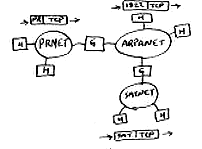
To envision the future, one must also be cognizant of the past. To understand the Net, one must go beyond its recent origins in the military's decentralized array of interlinked computers known as the ARPA Net. James Carey in Communication as Culture: Essays on Median and Society (1988) points to the telegraph as the true origin of the Net for it decisively separated communication from transportation, markedly aiding capitalist exchange. Signs could then move independently of geography, a universal form of exchange that created deterritorializing and reterritorializing flows (this idea is broached in Karl Marx's Grundrisse and in further developed in Gilles Deleuze and Felix Guattari's tome Anti-Oedipus: Capitalism and Schizophrenia, 1972). This situation is now hyper-realized in the Internet, whose reconceptualization by the Clinton Administration as "The Information Superhighway" is nothing other than an attempt to assert this connection between capital, communication media, and the nation-state, countering the anarchic, rhizomatic potential of the Net with a global shopping mall. Speaking of this point of view, Wired's 28-year-old managing editor, John Battelle, states: "You're still going to have sponsorship, advertising, the rules of the game, because it's just necessary to make commerce work." Or, as Arthur Kroker wittily turns this around from his Marxist perspective, the Infobahn is "not a wired culture, but a virtual culture that is wired shut."
On the other hand, in "Markets and Antimarkets in the World Economy" (1996), Manuel De Landa, a postmodernist philosopher, cautiously envisions a more positive moment. He posits meshworks (akin to Deleuze and Guattari's notion of the rhizome, an array of interconnected tubers) of small, decentralized producers using networked computers as a centrifugal counter force to the multinational corporation's hierarchical and centralizing tendencies which "may one day play a crucial role in adding some heterogeneity to a world-economy that is becoming increasingly homogenized."
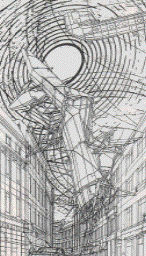
(Left): "Berlin Free-Zone," a section through freespace;
(Right): "Zagreb Free Zone," freespace structure in place
(suspended), Lebbeus Woods, architect (1991)Less cautious, more utopian, experimental New York architect Lebbeus Woods has proposed his sketches of the "Berlin Free-Zone" and "Zagreb Free-Zone" projects as hidden cities composed of interior landscapes joined via an electronic web of instrumentation. These free-zone super Nets, as described in his essay "The Question of Space" (1996), would constitute "ever-changing interactions among people, a community utilizing unlimited free access to communications," and "to other, more esoteric, networks at present reserved for the major institutions of government and commerce." This community is envisioned as "a parallel culture" rooted in, as he puts it, "the vagaries of dialogue. . . of self-inventing individuals, nurtured by their continual spontaineity and play." This would initiate what Woods calls "freespace," wherein "what is lost is the familiarity of architectural and social norms, the reassurance of control by stable authority, and of predictability, certainty, and the routinization of behavior." In describing his vision, Lebbeus coined the term "heterarchic" to refer to this new social and spatial structure.
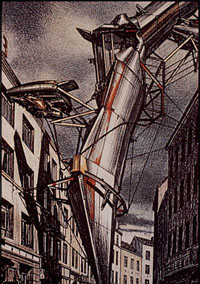
(Left): from "Underground Berlin"; (Right): from "Zagreb Free-Zone"
Lebbeus Woods, architect (1991)Here is a landscape of continually shifting authority that is rooted in dialogue, always conflictual, where a single person can not retain authority for very long. This would give free reign to postmodernist Jean-François Lyotard's very anti-Habermasian notion of incommensurate language-games, i.e., a production of knowledges (note the plural) that would result in the proliferation of debates and instabilities, rather than the narrowing induced by consensus. Woods foresees a "subtle and dynamic relationship between the material realm of architecture and the dematerialized realm of electronic instrumentation," which "becomes cybernetic in the continuous act of inventing reality." Here we see a utopic conflation of materialism and idealism, rationalism and intuition, of techno-science with cyberculture -- what cyber-enthusiast Douglas Rushkoff calls "Cyberia." It is all at the behest of a postmodernist challenge to the ideology of central authority that is aimed at achieving an intense, poetic derangement of that stable, authoritative mode of discourse -- a guaranteed mind-warping cyberpunkish experience increasingly free of physical constraints, boring predictability, and linear events. But is this merely one of those "daydreams of the relatively privileged," as author Mark Dery argues in Escape Velocity, in which it is once again assumed there exists a technological solution to every human problem? Dery goes on to describe how far this "Cyberian" vision of techno-transcendentalism has been carried recently in the thought of Manuel De Landa. Wedding James Lovelock's 1974 Gaia Hypothesis of the earth as a homeostatic system with Jerome Clayton Glenn's contention that the earth will soon have as many human inhabitants as there are neurons in the human brain and will then somehow form a collective consciousness, with Rushkoff's notion that the planet itself may become self-aware, De Landa conjectures in War in the Age of Intelligent Machines (1991) that the out-of-control growth of the decentralized, nonlinear Internet could result in the emergence of a global artificial intelligence, just as Chaos Theory has shown how a new kind of order spontaneously arises out of chaos! Cyberpunk novelist William Gibson envisions a technopagan version of this scenario in Count Zero and Mona Lisa Overdrive where cyberspace is inhabited by artificial intelligence (AI) programs that have evolved into something like a pantheon of voodoo dieties known as the Ioa.
And so the debate rages on: Is the Infobahn is a harbinger of utopia or dystopia? Will it put us in the "ejection seat," propelling us in an ascension rite for cyberculture into a New Age and a New Body? Cyberbody performance artist Stelarc (Stelios Arcadiou) thinks so.
In "Prosthetics, Robotics and Remote Existence: Postevolutionary Strategies" (Leonardo 5, 1991) he claims that "the most significant planetary pressure is no longer the gravitational pull but rather the information thrust. . . . Information propels the body beyond itself and its biosphere. Information fashions the form and function of the postevolutionary body." But will this postevolutionary body be, akin to the soulless Borg in Star Trek: The Next Generation, be merely hardwired into a world "Imagineered" by global corporations where we will be increasingly isolated even has we are "communified" in artificial communities? This is form of controlled/patrolled community, of course, has been envisioned in its dystopian form in Neal Stephenson's novel Snow Crash (1992) with its autonomous entities called "Burbclaves," and already partially realized in its a supposedly utopian form in sunny Florida at Disney's EPCOT and in Celebration, a Disney-financed privatopia for "mallcrawlers" which one critic called "Bedford Falls on Prozac." Yet maybe the computer and its spin-off technology is a Janus-faced technology, both liberating and repressive?
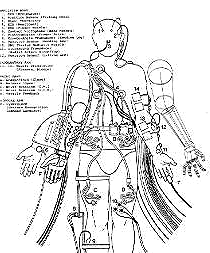
Amplified Body/Third Hand/
Virtual Arm, Stelarc (1995)Sadie Plant develops Donna Haraway's liberating conception of the feminist "cyborg." She cites Brenda Laurel's observation in "When women talk about V.R." that women don't imagine VR as entailing leaving the body behind as men envision -- a loss welcomed in Socrates's conception of the body as a hindrance to pure knowledge. "The body is not simply a container for this glorious intellect of ours," continues Laurel, whose point is re-enforced in "Virtual Bodies" by Catherine Richards who claims therein that body "is an entity so plugged in that it is indistinguishable from its environment challenging any notion of bodily identity." Developing a feminist conception of body, Richards goes on to say this is a body which "has little to do with the image of boundaries and perhaps more to do with an ecology of fluctuating intensities or environments of interdependent entities." Gerard Hovagimyan, in Thing Reviews (22 December 1995), captures the gist of how this ambiguity toward our emerging technology has emerged in the very critique of new technology as manifested in the writings of Critical
Art Ensemble:
science-directory.net - web
directory
![]()
![]()